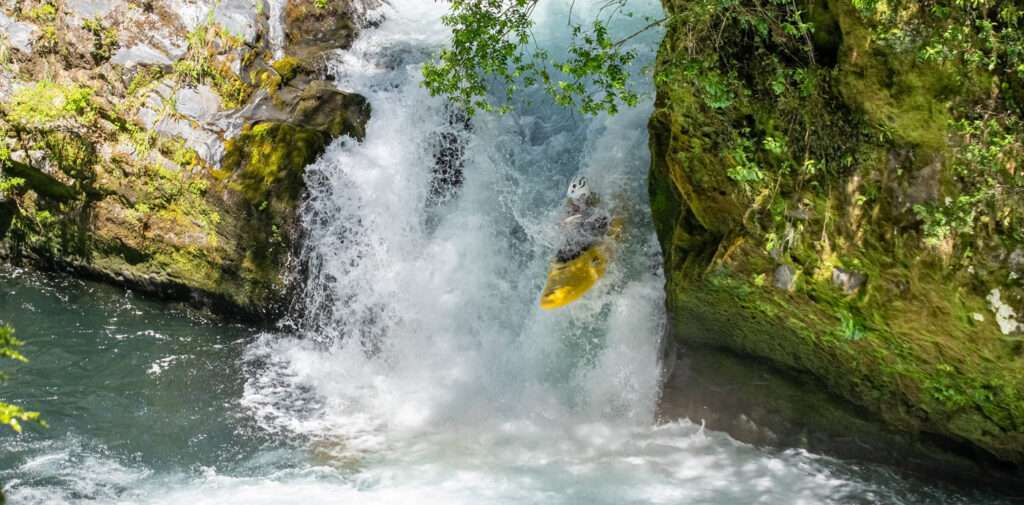Due to the nature of our activities, we are often throwing ourselves off clifftops into the lake, climbing waterfalls, or just being rained on. However, even when we are not in the water, and perhaps up in the mountains on a sunny day, there is still a chance it might rain or get a bit breezy. Who knew, right? We are therefore pretty used to dealing with the weather spectrum, and so would like to offer a little outdoor clothing help with your visit to those fantastic, but sometimes wet and cool, areas of the United States.
6 Tips to Stay Warm While Kayaking
1. Layer Up
Firstly, like many other outdoor types, we find that having lots of thinner lightweight layers is more practical, like having a thermostat with lots of different settings. Having one big fleece only gives your thermostat 2 options – uncomfortably hot or cold.
2. Understand Waterproofing
Something that a lot of people forget is that just like frogs, all humans are waterproof. The thing we really need to focus on is staying warm, and how to adjust your clothing to ensure this happens. Now don’t get us wrong, being dry is important too, but if you ask any experienced walker, they will tell you there is no such thing as a totally waterproof garment. Either the rain gets in through sheer tenacity, or the moisture your body generates during activity gets trapped and makes you damp from within. So having plenty of layers is helpful once again, as you can change into dry clothing if the weather, or activity, has rendered the first set useless.
3. Be Windproofed
We still pack our waterproof clothing, because even if the heavens open and the rain soaks through to our underwear, it will still provide a windproof layer. A windproof for us, as outdoor folk who spend a lot of time, well, outdoors, is just as important, if not more so than a waterproof layer. Ever got out of an outdoor swimming pool and then been hit by a breeze that makes you shiver, whilst everyone else is sat around quite happily in the wind? This is because when skin gets wet and is exposed to wind it can cool down up to 20 times quicker than when you are dry. That’s why when you are wet even a warm wind can feel cold.
4. Don’t Wear Cotton
Choosing the right materials for outdoor wear is extremely important and the biggest outdoor clothing sin is cotton. A little fact for you here; cotton can hold up to 5 times its weight in moisture, and when it gets wet it no longer insulates. It actually cools you down. Whether it’s because you have been caught out by the rain or because you’re sweating under your Gore-Tex jacket, cotton t-shirts and jeans will stick to your skin and can potentially cool you to hypothermic temperatures (even in the middle of summer). For your next-to-skin layer or ‘base-layer use fabrics that ‘wick away moister’, this means that the fabric works to take water and moisture away from the skin, keeping you drier and warmer in the process. Wool and man-made fibers such as polyester are ideal for this.
5. Protect Your Extremities
Don’t forget about your face, hands, and feet. Hats, gloves, and socks are also vital components, as when temperatures drop our bodies’ main goal is to keep our vital organs warm. Therefore, it lessens the blood flow to our extremities to increase the blood and heat flow to more essential areas. The same applies to these areas as already discussed, so avoid cotton socks and have several pairs of gloves in case one pair gets wet. For certain water activities neoprene works very well. Although it gets wet and allows water to seep through to the skin, it is designed to trap a thin layer of water between the material and skin which the body then heats up, creating an insulating layer. Therefore, wetsuits and neoprene socks & gloves can be very useful.
6. Keep Moving
Honestly, this is our big secret. If you stop moving you will allow your muscles to get cold, and the best way to warm up again is to exert some energy and get moving. Of course, we don’t just go out with nothing on and assume that if we keep going, we will stay warm, we dress accordingly and plan ahead in preparation for the weather forecast. You are also the only person who truly knows how your body deals with different temperatures. If you feel the cold and colder weather is forecast, then pack extra layers. If you are a warm person and you sweat a lot, still bring several layers, but so you can change into fresh clothes to enable you to stay comfortable and dry.
Simple hints and tips like these come from being regularly outside in all manner of conditions, especially on those occasions when you can get all 4 seasons in one day. So, if you are concerned about keeping warm, we encourage you to take our advice so that you can go outside and enjoy it. Whatever happens on your day out, don’t let getting wet and cold hold you back. Just make sure you are prepared for whatever the weather, and a smile and a sense of humor is always a help.

